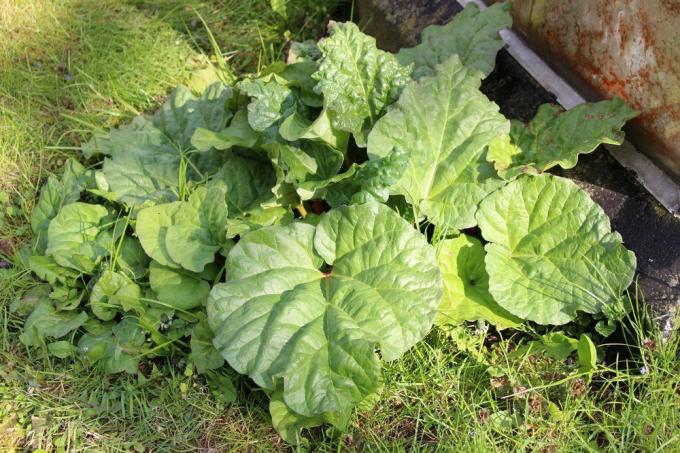
table of contents
- Rhubarb varieties
- Cultivation
- Location
- floor
- sowing
- Transplanting
- care
- to water
- Fertilize
- Diseases
Profile and care information open +conclude -
- Flower color
- White
- Location
- Partial shade, shady, sunny
- Heyday
- June July
- Growth habit
- upright, spreading, bushy, perennial, clump-forming, perennial
- height
- up to 150 centimeters high
- Soil type
- sandy, loamy
- Soil moisture
- moderately moist, fresh
- PH value
- neutral, weakly alkaline, weakly acidic
- Limescale tolerance
- Calcium tolerant
- humus
- rich in humus
- Poisonous
- Yes
- Plant families
- Knotweed Family, Polygonaceae
- Plant species
- Useful plants, bedding plants, Perennials
- Garden style
- Kitchen garden, self-catering garden, perennial garden
rhubarb belongs together with asparagus, and spinach Strawberries every spring and the sticks in the red-greenish hues are good as jam, syrup and in cakes. The original Asian knotweed grows easily in German gardens and can be used from May to St. June to be harvested. The “barbarian root”, as the Romans called Rheum rhabarbarum, inspires with its slightly sour taste, which is typical of the stem vegetables.
Rhubarb varieties
The rhubarb varieties at a glance
Rhubarb has a really wide variety of varieties, but the following are especially suitable for direct cultivation in home gardens. These are different in taste and acidity. The following applies here: the greener the sticks, the more oxalic acid and less sugar the rhubarb contains.
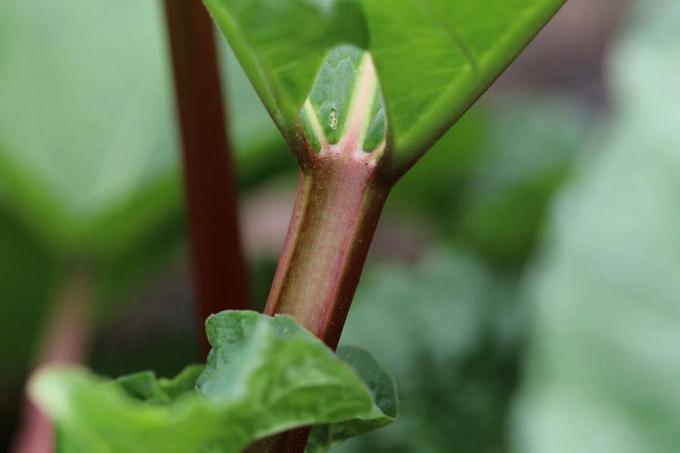
Holstein blood
- red-stemmed, high sugar content, less acidity, high yields
Holstein noble blood
- like Holstein blood, only finer in the sows, less yields
Esta
- deep red, light acidity, can be harvested early
Goliath
- largest variety of rhubarb, green-stemmed, not so sweet, stems up to 90 centimeters long
Frambozen rood (raspberry rhubarb)
- raspberry red sticks, high yields, fruity
The Sutton
- reddish-green sticks, easy to maintain
Elm Jewel
- red sticks, rather smaller in size, mild in taste
Vierlander blood
- deep red stalks, extremely productive, quite sweet and mild
There are other varieties, but these have proven themselves especially in German gardens. The plant originally comes from the Himalayan regions and the root is used there in Chinese healing arts. The individual rhubarb varieties were only used as food in the 19th century. In the 20th century and in the years that followed, the knotweed plant found its way into desserts and spreads. You can proceed in exactly the same way with the rhubarb varieties in terms of cultivation and sowing, as they do not have any special care requirements and have exactly the same growth. The only things that differ about the varieties are the height of growth and crop yields.
Cultivation
There are three ways to grow a rhubarb:
- sowing
- Plants through rhizomes
- transplant an acquired specimen
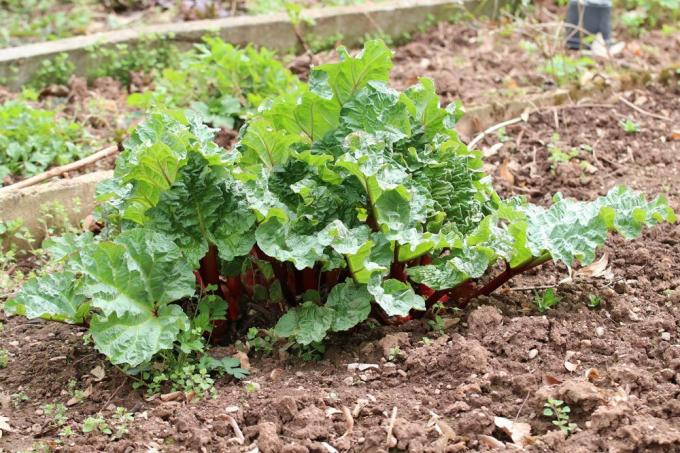
Depending on the time required, availability and benefit, one of these three methods is recommended to enrich your own garden with a rhubarb. If you are in a hurry, you should either purchase a finished copy or, if available, a portion of an existing copy. Seeds also work, it only takes at least two years before you can harvest the first stalks of rhubarb. Due to its long lifespan, the first 15 years in particular are considered to be extremely productive and gardeners can therefore continue to sow their seeds if they have enough time. Before planting, however, you should first prepare the location.
Location
Rhubarb is an extremely undemanding perennial in terms of care, but should be in a suitable location to encourage growth. The stronger the growth of the plant, the higher the yields.
The following properties must be taken into account:
- Light requirement: sunny to partially shaded
- more sun than shade
- tolerates wind
It is typical to plant the plant in the garden bed, but there are numerous other places where the powerful growth of the plant can show itself. Bare house walls or around the are popular here garden pond, because especially the rhubarb varieties with the red sticks are an appealing eye-catcher. Since the knotweed grows as a perennial, it can cope very well with wind and harsh weather conditions, as long as the amount of light is right in spring and summer.
floor
The soil is the most necessary basis for the rhubarb to sprout healthy and strong. This should be nutrient-rich and permeable, because Rheum rhabarbarum does not tolerate any form of waterlogging and can perish as a result.
Therefore, pay attention to the following characteristics when it comes to the location:
- nutritious
- humus
- wet
- sandy
- profound
- permeable
- pH: 5.6 to 7.2
The rhubarb likes to spread on sandy soils. These can dry out for a few days in summer and then watered again, which the knotweed plant likes. The soil should be prepared accordingly for planting so that the new plants can be planted directly in it.
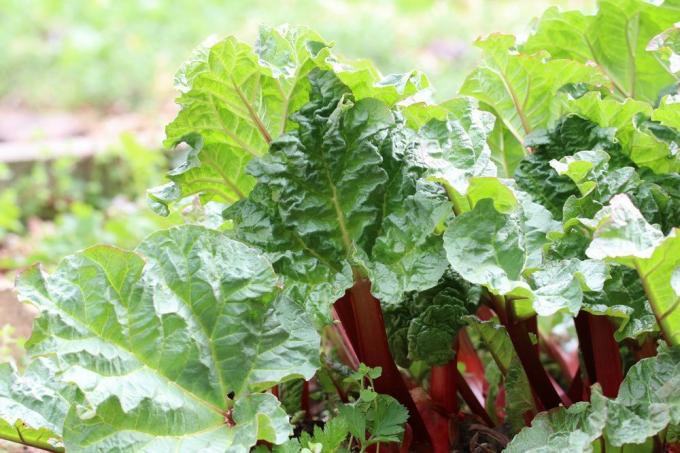
Proceed as follows:
- choose a location with enough space, rhubarb wants to develop and grow undisturbed, the perennial is good for that
- the individual varieties require different amounts of space: red varieties such as Holsteiner Blut require at least one square meter of their own, while green varieties Varieties like Goliath need at least 130 by 130 centimeters - more space is always better here, because the rhubarb forms a richly branched one Shallow root system
- dig up the site thoroughly, removing whatever appears weed - dig a little deeper here to catch more root weeds
- Work in a layer of deciduous humus, especially in sandy soils, to make it a little more permeable, alternatively you can also use other compost or horn shavings
- then you can use the plants, whether as young plants or rhizomes
Tip: Soils that have previously had rhubarb should be avoided as a site for seven years. The soil structure was adapted by the growth of the plant in such a way that young plants are no longer compatible with the soil.
sowing
Of all the variants, sowing is the most difficult and at the same time not very successful. Therefore, seeds are rarely offered for sowing, as rhubarb often weakens when sowing and only allows low yields, if at all. But sowing the seeds is quite easy, but time-consuming. The best time for this is spring between mid-February and early April.
The sowing in detail:
- prepare a planter with nutrient-rich quality soil
- sow the seeds on it
- cover them with soil a few millimeters
- moisten the earth
If you are lucky, individual seedlings will show up eight to ten weeks after sowing, which must be pricked out after sprouting. Simply use small pots for this. From autumn onwards, when the seedlings are growing well, you can take them outside. It may well happen that no seedlings sprout when sowing, as this knotweed plant spreads more through rhizomes than through the flowers, even in the wild.
division
The division is a safe way to plant new rhubarb and benefit from previous plants that you may already be keeping in the garden. The best time for this is either spring from March to the end of April or autumn from the beginning of September to the end of October. During this time, the rhubarb has enough time to sprout effectively and form sturdy stems and flowers, the stems of which can grow taller than two meters. Use large, voluminous pieces that weigh at least 500 grams and have enough buds.
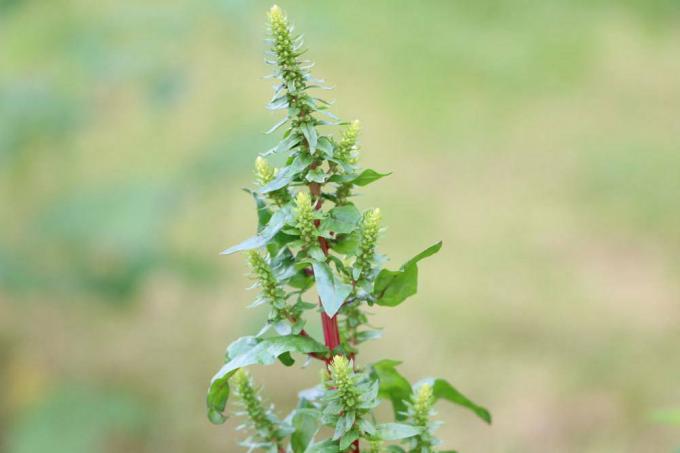
Put these in the ground as follows:
- decide on a section, preferably meaty and heavy enough
- put this in the ground at a depth of three centimeters
- cover the piece of rhizome with a thin layer of soil
- the buds should still be easily recognizable here
- moisten the soil and let the rhizome rest
A big advantage of this variant is that you don't have to buy a new one if you already have a rhubarb. You can then simply share this and thus have two rhubarb plants in the garden for the next year. The division also works perfectly for propagating the plant. If you want to propagate these, all you have to do is take a spade, expose the root, and cut a good chunk out of the rhizome. You can then use this for propagation.
Transplanting
Transplanting is another way to plant a rhubarb in the garden. You use a complete plant, which you obtain either from a specialist retailer or another source and then put in the garden. Simply remove the tub in which the plant was delivered and examine the roots for pest infestation and rotten areas. Roots that are rotten or broken can be removed with sharp, clean scissors. Then put the rhubarb in the ground and cover it with soil until only the stalks are visible. Then it is essential to keep the soil moist.
care
Whether you have decided to sow seeds or plant them, care is important to keep Rheum rhabarbarum healthy. Despite the strong growth, the plant is quite undemanding and thrives extremely well when the ratio of watering and fertilization is right. It is important that you remove the numerous budding flower games as soon as they appear. Otherwise the rhubarb would concentrate too much on this work, which means that the harvest in spring is poor. As soon as the knotweed plant begins to rest, you should remove all dead superficial parts of the plant.
Tip: If you can do without an abundant harvest, you should let the rhubarb plant develop flowers. You can pick these and then prepare them in numerous dishes similar to broccoli.
to water
Watering is essential when caring for a rhubarb as the perennial is very thirsty. Sufficient watering is necessary, especially in summer and the main growing season from May to June, as the formation of the fruity stalks costs a lot of energy. Water regularly and be guided by the rain. The more it rains, the less you have to water and vice versa. Check daily whether the top layer of the soil is dry and water accordingly. You do not need to water over the winter, as the plant goes into the dormant phase as early as October and most of the upper parts of the plant die off.
Tip: Mulch the knotweed family in spring to provide the plant with sufficient moisture over the summer. Do not cover the buds, otherwise growth will be restricted.

Fertilize
After planting, fertilizing provides the rhubarb with the nutrients it needs to form the strong plant material. Organic fertilizers can be used for fertilization, which you can use to loosen the soil in spring. After the harvest, you can then supply the plant with a classic vegetable fertilizer, for example from Compo, Naturen or Dehner. Thereafter, no further fertilizers are required and the rhubarb does not need either, as it is now completely prepared for wintering. From the resting phase, however, add a layer of bark mulch or compost over the plant as a cover. This will then be incorporated in the spring.
Diseases
Pests are not a problem for the plant. Even moles and snails cannot harm Rheum rhabarbarum. The only problem is leaf blotch infestation, which you can see from the sudden appearance of numerous spots on the surface of the leaves. Remove the leaves and dispose of them with household waste, then use a preparation made from network sulfur for prevention.
